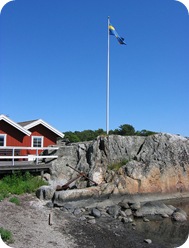Day 10/30: The international butterfly

When I first realized that many Indo-European languages had completely different words for butterfly, I thought it was really cute. Of course, it’s not surprising at all, since that’s what different languages are all about, having different words for different things – but on the other hand, when closely related languages, like the Germanic and Romance ones, have words that differ from each other to such a great extent, it’s intriguing to say the least. It seems that those words have evolved separately, instead of having developed from a common source, like many other words within closely related branches.
A quick Google search confirmed that I wasn’t the first one to get intrigued by that. For example, this message on the Linguist List suggests an interesting approach:
The word for butterfly is a transfer of a gestural mimicking. The different words in the various languages are the result of a motor transfer from the gestural motor program to a structurally corresponding articulatory motor program, a manifestation of what neurologists have termed ‘motor equivalence’. The words all derive from visual perception of the characteristic pattern of flight of the butterfly; the words are not arbitrary but reflect the structure of what is seen. […] In the case of words listed for ‘butterfly’, the associated bodily gesture generated by the sound-structure of each word is a flapping movement of the arms and hands which represents the flight of the butterfly.
So, what that message says is that what’s behind many of the butterfly words is motor equivalence; the words were actually shaped so that their sound mimicks the flapping movement associated with the butterfly. Indeed, some of the words do show such kind of sound pattern, such as the Italian farfalla and the Portuguese borboleta. I have compiled a small list of words for butterfly in Indo-European languages, and a more comprehensive one can be found here.
Afrikaans: skoenlapper
Czech: motýl
Danish: sommerfugl
Dutch: vlinder
English: butterfly
Faroese: firvaldur
French: papillon
German: Schmetterling
Icelandic: fiðrildi
Italian: farfalla
Latvian: tauriņš
Lithuanian: drugys
Luxembourgish: Päiperlék
Modern Greek: πεταλούδα
Norwegian: sommerfugl
Portuguese: borboleta
Russian: бабочка
Spanish: mariposa
Swedish: fjäril
Day 8/30: On nuts and etymologies
 I baked peanut butter cookies today. They are totally awesome. I also started to think about the etymology of the word peanut, which I decided must be completely obvious, since peanuts do resemble peas, sitting snuggly in their cozy, tiny pods. But what about other nuts? Walnuts, for example? There’s nothing special about a walnut that makes it similar to a… what? In Swedish, the word for walnut is valnöt, which might make one think it’s somehow related to val, meaning whale (as well as choice and election, but these are way less spectacular). Of course, I fully realized that such a coincidence is purely coincidental, and that walnuts have nothing to do with whales… But if they do have anything to do with ANYTHING in the first place, what’s that?
I baked peanut butter cookies today. They are totally awesome. I also started to think about the etymology of the word peanut, which I decided must be completely obvious, since peanuts do resemble peas, sitting snuggly in their cozy, tiny pods. But what about other nuts? Walnuts, for example? There’s nothing special about a walnut that makes it similar to a… what? In Swedish, the word for walnut is valnöt, which might make one think it’s somehow related to val, meaning whale (as well as choice and election, but these are way less spectacular). Of course, I fully realized that such a coincidence is purely coincidental, and that walnuts have nothing to do with whales… But if they do have anything to do with ANYTHING in the first place, what’s that?
So, I took the cookies out of the oven and logged in to the good old Oxford English Dictionary, ready to research the origins of some interesting nut-words. I started, obviously, with nut, just to make sure where it comes from:
- Nut is an old Anglo-Saxon word. There’s no information on HOW old it is exactly, but it was known as hnutu in Old English. It most probably comes from the Proto-Germanic *khnut and the Proto-Indo-European *knu (the asterisk denotes a word that has been reconstructed on the basis of our knowledge of language development, but that has no actual evidence behind its existence).
- Walnut is, essentially, foreign nut. The wal- part comes from the Old English wealh, meaning foreign, which is also related to today’s Welsh. Just as the Welsh were foreigners to 11th-century Englishmen (the first recording of walnut comes from ca. 1050), the walnut, originating from Italy, had to be differentiated from the good old hazelnut. The OED makes an interesting remark on the origin of walnut:
The solitary OE. example (in a glossary c1050) is the earliest known appearance of the word in any language. The word must, however, have come to England from the Continent, but there is no evidence to show whether it belonged to the primitive OE. vocabulary, or was introduced at a relatively late date.
- Hazelnut seems to be a much older word; the first known recording is dated 725. Hazel was hæsel in Old English and comes most probably from the Proto-Germanic *khasalaz.
On a side note, the first to use hazel in the meaning "the color of hazelnuts, pertaining to eyes" was William Shakespeare:
Thou wilt quarrell with a man for cracking Nuts, hauing no other reason, but because thou hast hasell eyes.
Romeo & Juliet III. i. 22
- Peanut, finally, has exactly the etymology you’d expect it to – it’s a nut that resembles a pea. There’s something interesting about its usage, though. The first recorded instance of peanut, from 1794, refers not to what we today know as the peanut, (Arachis hypogaea) but to the nut of a completely different plant (Castanea pumila). This meaning is, of course, not used today anymore. The first to use the word in today’s meaning was Washington Irving, who in 1802 wrote:
I amused myself with eating pea-nuts.
- Good for him :)
Day 7/30: Blueberry pie recipe

To be honest, I’m not a big fan of blueberries, or any berries in this respect. Most of the year, I vehemently ignore their existence. I also could name a thousand pastimes more exciting than picking blueberries… But I somehow got stuck in the forest anyway, and gathered almost 1.5 litres of them in the last two days. There’s something special about picking berries, despite (thanks to?) all the complimentary forest-y attractions like ants, spiders and the hard ground under my ass, not to mention the pain of bending / crouching over the tiny bushes.
But I think I’ll continue tomorrow. After all, it’s free food, growing like that in the forest near me – and not just any food, as blueberries are supposed to be freakishly healthy. And if there’s any way to make some healthy food even healthier, putting it into a pie definitely counts. I ate half of it still hot, and I’m not a big fan of blueberries in the first place.
- Ingredients
- for the crust:
- 100 grams butter
- 180 grams flour
- 80 grams sugar
- 1 egg
- 1/4 teaspoon baking soda
- for the filling:
- 1/2 litre blueberries
- 40 grams sugar
- zest from half a lemon
- 1/2 tablespoon potato starch
- for the crust:
- Make the magic happen
- Preheat the oven to 200˚C
- Mix all the crust ingredients and knead them into a soft dough
- Put aside some 1/3 of the dough and line a pie dish with the rest
- Prebake the crust for about 5 minutes so that it doesn’t soggy once the filling is added
- Carefully mix the berries with the other filling ingredients
- Put the filling onto the crust
- Take the dough you’ve put aside and either sprinkle it over the pie or make a decorative lattice
- Bake the pie for about 20-30 minutes
- When it’s ready, do leave it alone for a few minutes!
Day 6/30: My favorite free resources for learning German
 Is it expensive to learn a foreign language? All those textbooks and audio courses and grammar books you can find in your nearest bookstore aren’t free… But do you really need them to gain basic skills – and develop them further, if you like – in your language of choice? If you’ve decided to study one of the most popular languages, you’ve struck it lucky. There are plenty of free resources out there – on the internet! Finding them might not be easy, so I’ll share some of my favorite German resources with you. German definitely is a big language – many people speak it, and equally many people study it, so no wonder there are a couple of interesting, free resources on the internet!
Is it expensive to learn a foreign language? All those textbooks and audio courses and grammar books you can find in your nearest bookstore aren’t free… But do you really need them to gain basic skills – and develop them further, if you like – in your language of choice? If you’ve decided to study one of the most popular languages, you’ve struck it lucky. There are plenty of free resources out there – on the internet! Finding them might not be easy, so I’ll share some of my favorite German resources with you. German definitely is a big language – many people speak it, and equally many people study it, so no wonder there are a couple of interesting, free resources on the internet!
The BBC Languages website is a good starting point if you’re a beginner, especially if you want to quickly learn some basic vocabulary and phrases before a trip to Germany. Just choose the German Steps section, and you’ll find everything you need to start speaking in a variety of situations, such as introducing yourself, sightseeing and shopping. Here you’ll also find useful cultural notes, thanks to which you’ll be able to better understand the German culture and thus enjoy your travel experience even more.
Mission Europe is made for people who are "interested in language and like crime stories," as we can read on their main page. An interesting idea! To start learning German, click on Mission Berlin. This isn’t your regular language course, but more of an interactive language game!
Deutsche Welle is a real treasure trove for German lovers, both those starting their learning adventure and those more advanced. If you’re a beginner, make sure to check out Deutsch Interaktiv, a comprehensive course that will take you up to the B1 level. You can also listen to a special podcast for beginners, Radio D. Download the episodes to your mp3 player and listen to them when you have some free time – listening comprehension is one of the most important parts of language learning, after all.
Deutsch – warum nicht? is another free course produced by Deutsche Welle. You can start with it if you’re a complete beginner as well, and it will take you pretty far. After you’re done with it, you can check out Wieso nicht? – a similar course for more advanced learners.
And if you already have a pretty solid knowledge of German, and would like to learn some business language, there’s a course for you as well – Marktplatz.
Deutsch XXL is perfect for you if you already feel pretty comfortable with German, but still not ready for making the progression to original German media. You can, for example, download news programs that are spoken more slowly and clearly, together with accompanying transcripts that you can read to make sure you didn’t miss any important words. Deutsch XXL has many more features for advanced learners, and I recommend it to everyone who wants to learn more about the German language, people and culture!
This is just a small fraction of what the internet has to offer for German learners.
Day 5/30: What does word order reveal about our minds?
What kind of word order do most languages use?

I’ve been reading up on how different language structure their sentences recently, and noticed a couple interesting things concerning word order. To describe a language’s unmarked (most commonly used in declarative sentences) word order, you have to look at the three most important elements of a sentence: the Subject, the Verb and the Object. The basic word order in English is exactly that:
| The cat | ate | the fish. |
| Subject | Verb | Object |
Languages like French, Spanish, Russian, Swedish, etc. are very similar to English in this respect: actually, most – if not all – Indo-European languages seem to share this pattern. Of course, some languages, such as the Slavic ones, allow the constituents to be moved around rather freely, but the basic word order is still SVO. The same for German, which has a SOV word order in some types of sentences.
There’s also a number of languages belonging to other families that use the SVO word order, such as Finnish, Khmer and Swahili. Thus, it’s easy to assume – particularly if you’re only familiar with Indo-European languages – that this is a feature that most languages in the world share.
This is, however, not true. If we take the number of languages as a criterium (as opposed to, for example, the number of speakers), the most common word order is Subject Object Verb. In this group we can find Korean, Japanese, Persian, Arabic, Hindi, Turkish, Basque… That’s quite a lot of languages from different families.
Now, what about the remaining four possibilities: VSO, VOS, OSV and OVS? This is when things start to get tricky. There’s only a handful languages (that’s been researched and analyzed!) that belong to those groups. As for VSO, there’s for example Classical Arabic, ancient Egyptian and Celtic languages. VOS languages include Fijian and Malgasy, belonging to the Austronesian family.
And as for Object-first languages (OSV and OVS), it seems only a few single cases have been found, such as Hixkaryana, Xavante and Apurinã, all spoken by indigenous tribes in South America.
Summary
The majority of the world’s languages is Subject-initial, using either the SOV or SVO word order. Verb-initial languages are much less common, but not unheard of. Object-initial languages are extremely uncommon.
What’s the meaning behind that?
There must be some. After all, if word order was assigned completely arbitrary, all the six patterns would be distributed evenly across languages. But they are not. For some reason, putting the subject first seems to be the most intuitive way to arrange information. So, does it reflect the way the human brain stores and processes information? Does it mean that for our minds, the doer is more important than the action? (Assuming that the constituent that comes first is indeed more important). Perhaps it just lies in the human nature that we want to know who performed an action first, and what they did later.
This is definitely a fascinating issue, but also rather confusing…
Day 4/30: German grammatical gender and noun suffixes.
 If there’s one thing that gives German learners much more pain and suffering than it really should, it’s definitely noun gender – I know from experience. In most of the cases, there’s no correlation between natural and grammatical gender. When you come to think of it, there’s absolutely no reason why a carrot should be feminine or a key masculine; grammatical gender is arbitrary and that’s why many learners consider it hard to learn. Rote memorization seems to be the solution, but there are some nice tricks you can use – at least for some groups of words – to learn more and faster.
If there’s one thing that gives German learners much more pain and suffering than it really should, it’s definitely noun gender – I know from experience. In most of the cases, there’s no correlation between natural and grammatical gender. When you come to think of it, there’s absolutely no reason why a carrot should be feminine or a key masculine; grammatical gender is arbitrary and that’s why many learners consider it hard to learn. Rote memorization seems to be the solution, but there are some nice tricks you can use – at least for some groups of words – to learn more and faster.
What are suffixes and how can they help you learn noun gender?
In the most basic terms, a suffix is a particular ending added to the stem of a word. You have certainly noticed that many German words end in the same few letters; particularly the suffix –er seems incredibly common! Another thing you might have noticed is that nouns ending with the same letters tend to have the same gender.
That’s why familiarizing yourself with a list of common noun suffixes can help you remember their gender! Just be careful – there are plenty of exceptions out there, especially when the most common suffixes are concerned. Still, even considering the exceptions, becoming friends with the suffixes can be tremendously helpful.
MASCULINE SUFFIXES (DER):
-er: Arbeiter, Krieger
Important exceptions: die Butter, das Fieber, die Schwester, die Tochter, die Mutter, das Silber, das Wasser, das Futter, die Feder, das Wetter, das Gewitter, die Kiefer, das Messer, das Opfer, das Zimmer
–ner: Falkner, Gärnter, Rentner
-ler: Sportler, Wissenschaftler
-ich: Rettich, Teppich
-ig: König
-ling: Günstling, Frühling
-ast: Palast
-or: Professor
Important exceptions: das Labor
-tor: Senator
-ismus: Tourismus, Journalismus
-us: Zyklus
-and: Doktorand
-ant: Komödiant
-än: Kapitän
-är: Funktionär
-at: Demokrat
-et: Athlet
-eur: Friseur
-iker: Physiker
-ist: Komponist, Pazifist, Pianist
-oge: Biologe
-nom: Astronom
FEMININE SUFFIXES (DIE):
-in: Lehrerin, Studentin
Important exceptions: das Benzin, der Urin, das Aspirin
-ung: Bedeutung
-t: Fahrt
-keit: Sauberkeit, Eitelkeit
-schaft: Mannschaft, Weltmeisterschaft
-sion: Explosion
-tion: Revolution
-heit: Gesundheit, Kindheit
-ie: Biologie, Drogerie
Important exceptions: das Genie
-ei: Bäckerei, Partei
Important exceptions: der Papagei
-a: Villa
Important exceptions: das Sofa
-ade: Limonade, Promenade, Parade
Important exceptions: der Nomade
-age: Demontage, Blamage
-anz: Eleganz, Distanz
Important exceptions: der Tanz
-enz: Residenz
-phie: Geographie, Biographie
-ik: Musik, Grammatik
Important exceptions: der Atlantik, der Pazifik
-ine: Violine, Apfelsine
-itis: Hepatitis
-ose: Neurose
-sal: Schicksal, Rinnsal
-sis: Skepsis
-tät: Universität
-üre: Maniküre
-ur: Natur, Konjunktur
Important exceptions: das Abitur
NEUTER SUFFIXES (DAS):
-chen: Mädchen, Kaninchen
-lein: Fräulein, Büchlein
-sel: Rätsel
-erl: Mäderl
-li: Müesli
-tel: Viertel
-eau: Niveau
-icht: Dickicht
-ett: Etikett
-ma: Dogma
Important exceptions: die Firma
-il: Ventil
-ing: Hearing, Jogging
-um: Datum, Königtum, Christentum
Important exceptions: der Irrtum, der Reichtum, der Traum
-ium: Studium
-it: Dynamit
Important exceptions: der Profit
-o: Auto, Abo, Kino, Kilo, Lotto, Radio
Important exceptions: der Zoo, der Euro, die Avocado
Day 3/30: 5 quirks of the Swedish language that make it awesome.
 Swedish, spoken by some 10 million people in Sweden and Finland, will probably never make it to the list of the most studied languages in the world. It might be because of its limited usefulness outside of Scandinavia, or because of the common belief that all Swedes speak English anyway – or, possibly, both – but, in any case, Swedish doesn’t seem to get much attention even among language passionates.
Swedish, spoken by some 10 million people in Sweden and Finland, will probably never make it to the list of the most studied languages in the world. It might be because of its limited usefulness outside of Scandinavia, or because of the common belief that all Swedes speak English anyway – or, possibly, both – but, in any case, Swedish doesn’t seem to get much attention even among language passionates.
But Swedish isn’t boring. Like any other language, it has a few adorable quirks and idiosyncracies that make it unique… Or annoying and a pain to learn, depending on your perspective!
- Definite forms of nouns are created not with an article appearing in front of the noun, like in many European languages including English, but by attaching a suffix to the end of the noun. The indefinite article, on the other hand, behaves just like in English.
- For example: en katt – a cat, katten – the cat; ett bord – a table, bordet – the table
- That’s kind of like saying catthe or tablethe ;)
- This kind of postfixed definite articles is found in other Scandinavian languages as well – which is not surprising, since they’re very closely related –
- but also in Bulgarian, Macedonian, Romanian, Albanian and Basque, which pretty much is.
- The so-called sje-sound is found exclusively in Swedish. No other language in the world seems to have it! It appears in such words as sjö (lake) or stjärna (star).
- It’s a voiceless fricative, transcribed as ɧ
- but its place of articulation isn’t easy to pinpoint, as it differs across dialects. It’s been described as velar and postalveolar, palatal-velar, palato-alveolar-velar, etc…
- Yes, it’s as hard to pronounce correctly as it seems.
- There’s a sample on Wikipedia you can listen to.
- It’s a voiceless fricative, transcribed as ɧ
- Swedish has quite a lot of vowels – some 17-18, depending on which of the many dialects you’re looking at. There are 9 basic vowels, but as they can come in either long or short forms, the number doubles easily.
- Vowel length isn’t something you can ignore if you want to speak comprehensible Swedish.
- You don’t want to confuse glass (ice-cream, short a) with glas (glass, long a), after all.
- Vowel length isn’t something you can ignore if you want to speak comprehensible Swedish.
- Just like Chinese, Swedish has tones.
- Kind of.
- Well, not really – it just has something called pitch accent.
- There are many pairs of words differentiated only by tone or stress.
- In those word pairs, the stressed syllables get either the acute or grave accent.
- For example: anden (the duck, acute accent), anden (the spirit, grave accent).
- Swedish learners usually have quite a hard time wrapping their head around this concept
- but, fortunately, unlike in Chinese, you can speak comprehensible Swedish without this advanced skill.
- Not all Swedish dialects have pitch accent; the one spoken in Finland, for example, doesn’t.
- Finally, there seems to be no limit to amazingly long compound words.
- Nagellacksborttagningsmedel, anyone?
- That’s nail polish remover.
- You’re probably not impressed if you have at least a fleeting familiarity with German, which offers endless possibilities for building long words as well. Well, Swedish and German are closely related, so it’s no surprise. Germanic languages and long words do seem to go together!
Day 2/30 – A custom-made keyboard layout is what every language lover needs
 If I were to point out one downside of using more than one language on a daily basis, it would be dealing with diacritics. You know, all those cute yet at times annoying "special characters" like the Polish ą and ę, the German ß, the Icelandic þ and ð or the Swedish å – not to mention the Spanish inverted punctuation marks ¡ and ¿. Even in English, there are words like naïve and fiancé, which – if you’re a stickler for proper spelling or just likely to get a small mental orgasm from looking at diereses and accent marks – seem to require more than your standard keyboard has to offer.
If I were to point out one downside of using more than one language on a daily basis, it would be dealing with diacritics. You know, all those cute yet at times annoying "special characters" like the Polish ą and ę, the German ß, the Icelandic þ and ð or the Swedish å – not to mention the Spanish inverted punctuation marks ¡ and ¿. Even in English, there are words like naïve and fiancé, which – if you’re a stickler for proper spelling or just likely to get a small mental orgasm from looking at diereses and accent marks – seem to require more than your standard keyboard has to offer.
If you type in more than one language, you probably deal with this problem by installing multiple keyboard layouts – one for every language you need – and switching as the need arises. This is by far the simplest and most intuitive solution, as neither adding the layouts or switching between them takes much time. But it’s far from perfect, especially when you have to change the language often. When creating a multilingual word list or flashcard deck for your studies, switching between the layouts after each and every entry gets more than annoying. And after a while you’d get confused anyway and stare at the screen blankly, trying to figure out why the right diacritics don’t show up.
It might seem like a minor detail, but it does take a lot of joy out of using the languages you’ve worked so hard on. Is there any way to make it easier?
Of course there is.
Make your own keyboard. One that has everything you need. Including ẘ. I don’t know how useful it is, but it looks cool, and I can type it whenever I want.
I never thought I’d recommend a Microsoft product, but there it is – the Microsoft Keyboard Layout Creator. A small, rather obscure, free app in which you can modify an existing layout (the fastest way to enrich your current keyboard with the special characters you need) or create your own one from scratch (more time-consuming, but you can do pretty much anything, including abandoning the good old QWERTY and making a layout that only you will be able to use. Having people try to type on your computer and realize something is horribly wrong – priceless!). You can also add non-letter characters that you’d like to have at hand, such as ‰ or ∞.
The obvious downside is that once you get used to your new keyboard, you won’t be able to type on anything else anymore ;)
What keyboard layout do you use? Do you often switch between languages?
